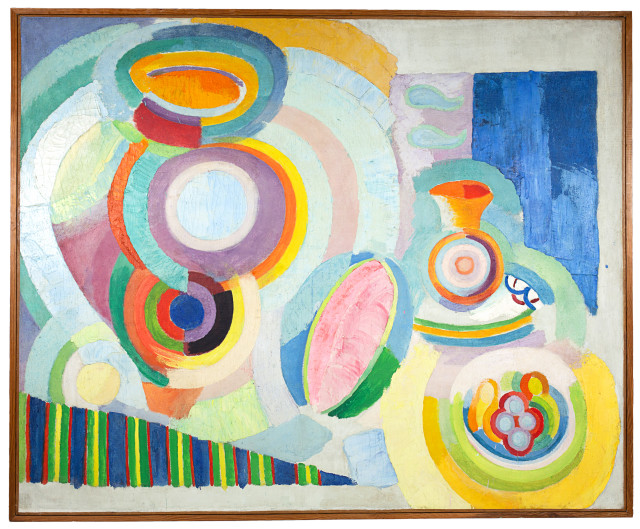- EN
Log in
- Live Auctions
- Past auctions
- More
- Gallery
- Art Dealing
- Publishing
- Kornfeld today
- The Story of Kornfeld
- Information



Paris 1885 - 1941 Montpellier
1916
Oil on canvas
171x211 cm
Marked on the canvas with the number "614", on the chassis with "W 102" and "60 LOS"
Pierre Francastel/Guy Habasque, Robert Delaunay, Du Cubisme à l'Art abstrait, Paris 1957, no. 186
Certificate of authenticity, signed by Jean Louis Delaunay and Richard Riss, dated 2.3.2021
Galerie Bing, Paris, W.102 (there titled "Nature morte aux pastèques époque portugaise")
Collection Franz Meyer sen., Zurich; through inheritance to
Private collection Switzerland
Paris ohne Jahr, Musée national d'art moderne, Delaunay, cat. no. 60, rückseitig mit Etikett
Bern 1951, Kunsthalle, Robert Delaunay, rückseitig mit Etikett und der Nummer "0321", cat. no. 40
Turin 1960, Galleria civica d'arte moderna, Mostra di Robert e Sonia Delaunay, no. 28, rückseitig mit Etikett
Wolfsburg 1961, Stadthalle Wolfsburg, Französische Malerei, rückseitig mit Etikett
On an old, but not original stretcher, probably mounted after transport from Portugal to Paris, craquelure in the impasto application of paint, individual, old restored spots, the canvas additionally, in the manner of French framers, the margins glued to the stretcher with paper strips. In very good overall condition, in a plain wooden frame
Delaunay is considered the main representative of Orphic Cubism, also called "Orphism". Guillaume Apollinaire coined this term when he saw Delaunay's "window pictures" (Fenêtres). The artist himself preferred to classify his art under the term "Cubisme écartelé" (fragmented Cubism), also created by Apollinaire. Delaunay intensively studied Kandinsky's writing "Vom Geistigen in der Kunst" (On the Spiritual in Art) and turned to pure, non-objective colour painting from 1912. With the outbreak of the First World War, however, a phase followed in which Delaunay again increasingly dealt with more representational painting. The Delaunay couple stayed in Spain in 1914 and did not want to return to France. From 1915 to 1917, Sonia and Robert moved to Vila do Conde in Portugal. Both were strongly fascinated by the rural surroundings and the warm light of northern Portugal. Markets, still lifes and people in traditional costumes suddenly appear in their works. What is exciting in Robert's work is the symbiosis of these representational elements with abstract motifs. Together they merge into a dynamic whole in which the colours are clearly in the centre. To give the works a special depth, he often mixed the oil paint with wax
The work offered here belongs to the series of Portuguese still lifes, of which he produced various large-format versions; the versions in the Musée d'art moderne de la Ville de Paris or in the Museo Thyssen-Bornemisza in Madrid are certainly well-known. "Nature morte portugaise" is probably the last of this series to be in private hands. A composition in which Delaunay's iconic "disques" expand into ornaments on a vase, the watermelon or the fruit on the fruit bowl. An incredibly powerful composition, created at the height of the Portuguese phase
1916
Öl auf Leinwand
171x211 cm
Bezeichnet auf der Leinwand mit der Nummer "614", auf dem Chassis mit "W 102" und "60 LOS"
Pierre Francastel/Guy Habasque, Robert Delaunay, Du Cubisme à l'Art abstrait, Paris 1957,
Echtheitszertifikat, unterzeichnet von Jean Louis Delaunay und Richard Riss, datiert vom 2.3.2021, liegt vor
Galerie Bing, Paris, W.102 (dort betitelt "Nature morte aux pastèques époque portugaise")
Slg. Franz Meyer sen., Zürich; durch Erbschaft an
Privatsammlung Schweiz
Paris ohne Jahr, Musée national d'art moderne, Delaunay,
Bern 1951, Kunsthalle, Robert Delaunay, rückseitig mit Etikett und der Nummer "0321",
Turin 1960, Galleria civica d'arte moderna, Mostra di Robert e Sonia Delaunay,
Wolfsburg 1961, Stadthalle Wolfsburg, Französische Malerei, rückseitig mit Etikett
Auf einem alten, aber nicht originalen Chassis, wohl nach dem Transport aus Portugal nach Paris aufgezogen, Krakelüren im pastosen Farbauftrag, einzelne, alt restaurierte Stellen, die Leinwand zusätzlich, in der Art französischer Einrahmer, die Ränder mit Papierstreifen auf das Chassis geklebt. In sehr gutem Gesamtzustand, in schlichtem Holzrahmen
Delaunay gilt als Hauptvertreter des orphischen Kubismus, auch "Orphismus" genannt. Guillaume Apollinaire prägte diesen Begriff als er Delaunays "Fensterbilder" (Fenêtres) gesehen hatte. Der Künstler selbst zählte seine Kunst lieber zu dem ebenfalls von Apollinaire kreierten Begriff "Cubisme écartelé" (zerteilter Kubismus). Delaunay befasste sich intensiv mit Kandinskys Schrift "Vom Geistigen in der Kunst" und wandte sich ab 1912 der reinen, gegenstandslosen Farbmalerei zu. Mit dem Ausbruch des Ersten Weltkrieges folgte jedoch eine Phase, in der sich Delaunay wieder vermehrt mit eher gegenständlicher Malerei auseinandersetzte. Das Ehepaar Delaunay hielt sich 1914 in Spanien auf und wollte nicht mehr nach Frankreich zurückkehren. Von 1915 bis 1917 verlegten Sonia und Robert ihren Wohnsitz nach Vila do Conde in Portugal. Beide waren stark von der ländlichen Umgebung und dem warmen Licht Nordportugals fasziniert. Märkte, Stillleben und Menschen in Trachten tauchen auf einmal in den Werken auf. Spannend ist bei Robert die Symbiose dieser gegenständlichen Elemente mit abstrakten Motiven. Zusammen zerfliessen sie zu einem dynamischen Ganzen, bei dem die Farben klar im Zentrum stehen. Um den Werken eine besondere Tiefe zu geben, mischte er die Ölfarbe oft auch zusätzlich mit Wachs
Das hier angebotene Werk gehört in die Serie der portugiesischen Stillleben, von denen er verschiedene, grossformatige Varianten erstellte, bekannt sind sicherlich die Versionen im Musée d’art moderne de la Ville de Paris oder im Museo Thyssen-Bornemisza in Madrid. "Nature morte portugaise" ist wohl das letzte dieser Serie, das sich in Privatbesitz befindet. Eine Komposition, in denen sich Delaunays ikonische "Disques" zu Verzierungen auf einer Vase, der Wassermelone oder den Früchten auf der Früchteschale erweitern. Eine unglaublich kraftvolle Komposition, entstanden auf dem Höhepunkt der portugiesischen Phase




